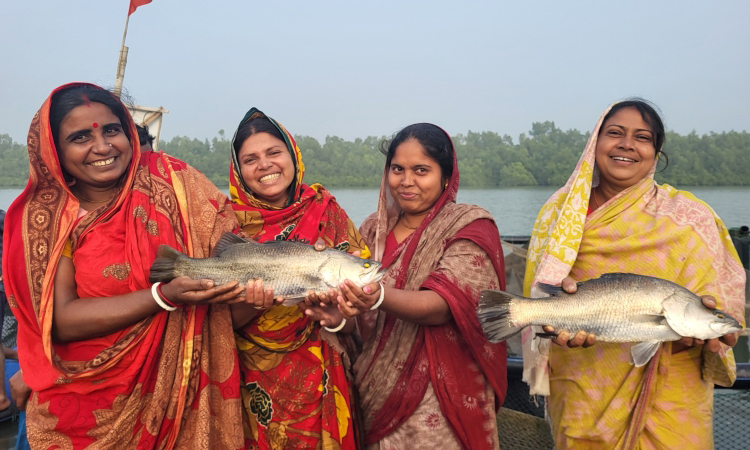News Flash
News Flash

MYMENSINGH, April 24, 2025 (BSS) – Bangladesh Agricultural University (BAU) researchers have made a major breakthrough in coral fish farming by developing methods to successfully raise the high-value species in floating seabed cages using artificial feed.
Farming of coral fish, valued for their taste and nutrition, has been facing challenges in Bangladesh due to limited access to quality fry and appropriate artificial feed. These constraints have restricted commercial production despite rising demand.
However, the BAU research team has now addressed these challenges. By producing appropriate fry and formulating effective artificial feed, they have opened the door to wider cultivation of coral fish in the country.
They have not only developed an innovative method for farming coral fish in cages but also found that the fish raised using this technique are of higher quality than those produced through conventional farming methods, according to their study.
The results of the study were announced today by the lead researcher, Dr Md Shahjahan, Professor of Fisheries Management Department at BAU.
This research was conducted under the Sustainable Coastal Marine Fisheries Project (SCMFP) funded by the World Bank and supervised by the Department of Fisheries, said Prof Shahjahan.
Jabed Hasan, a postgraduate student of the university, worked as an assistant in the research.
Prof Shahjahan explained that the primary objective of the research was to assess the feasibility of cultivating coral fish in floating cages using supplementary feed, marking the first such initiative in the country.
The fieldwork was conducted across three coastal regions: Munshiganj in Satkhira, Maheshkhali in Cox's Bazar, and Char Kukri-Mukri in Bhola. In each location, the local fishing communities actively participated in every stage of the process, beginning with the construction of the cages.
Discussing the cultivation method and feed management for coral fish in cages, the researchers explained that the cages are circular in shape, measuring 6.7 meters in diameter with a capacity of 60 cubic meters. Each cage can accommodate up to 15 fry per cubic meter.
The fish are raised using a two-stage cultivation process with artificial supplementary feed. The initial nursing phase, or pre-stage cultivation, takes place from January to March. After this period, the juveniles are transferred to the cages for further growth. The study confirmed that the use of artificial feed had no adverse impact on either the growth rate or the nutritional quality of the fish.
In a simultaneous another study related to it, researchers focused on feeding strategies for coral fish, known for their aggressive nature. Initially, the fish were fed pieces of tilapia fish, cut according to the size of their mouths. Over time, they were gradually transitioned to commercial feed, and eventually adapted to a high-protein supplemental diet containing 37 percent protein, formulated in the laboratory.
Regarding the final results and profitability of the study, the researchers reported that each cage produced an average of 800 to 850 kilograms of fish over the course of one year. This translates to a yield of 13 to 17 kilograms per cubic meter, whereas the average production per hectare in ponds or enclosures is 600 to 1500 kg. Additionally, the protein content of the cage-farmed fish averaged 19 grams, compared to 17 grams in conventionally farmed coral fish.
According to the calculations in the research and field experience, it is possible to ensure an income of about Taka 1.70 for an investment of Taka 1 in this fish farming in cages.
Moreover, since there is no land rent to use the river space, the cost of farmers is also reduced. A cage can be used for 5 to 7 years, where it is possible to cultivate about 1,000 kg of fish each time. Although cages are currently made of plastic, if marginal farmers want, they can also make them with bamboo or ordinary fishing nets at a lower cost.
Prof Shahjahan further said, “This method has less risk of disease, less risk of damage in natural disasters and there is no possibility of fish eating each other.”
“This fish can survive in saline water ranging from 0 to 35 ppt (parts per million), making it suitable for coastal farming,” he added.
Regarding the impact of this research on the livelihoods of marginal fish farmers, the lead researcher said, “Cage farming of coral will not only increase fish production, but also create alternative income opportunities for poor fishermen in coastal areas.”
He said this method will show a sustainable path for the development of mariculture by making the best use of natural resources.
The success of the research has proven that it is possible to farm marine fish commercially by acclimating them to cages and artificial feed, he said, adding, “This will increase our fish production manifold and strengthen Bangladesh’s participation in the blue economy.”